10 Basic Windows Commands for Beginners
Do you ever feel like navigating your Windows system is like a never-ending scavenger hunt? You click through endless menus and folders, just trying to find that one file or setting. That's where these commands come in. It’s like having a secret shortcut to get things done faster. Master these 10 basic Windows commands, and you'll not only streamline your workflow but also channel your inner hacker.
All the commands listed in this article can be used in both Command Prompt and PowerShell.
1 cd: Change Directories Easily
Navigating the Windows file system doesn't have to be a maze. The cd (change directory) command makes it easy to move around your directories.
To use the command, just type cd followed by the directory you want to navigate to. Need to quickly jump to your Documents folder from your home directory? Type this command:
cd Documents

Or maybe you want to go up one level; you can type cd .. which will bring you back to the previous directory. This can be useful if you need to navigate through different directories quickly.
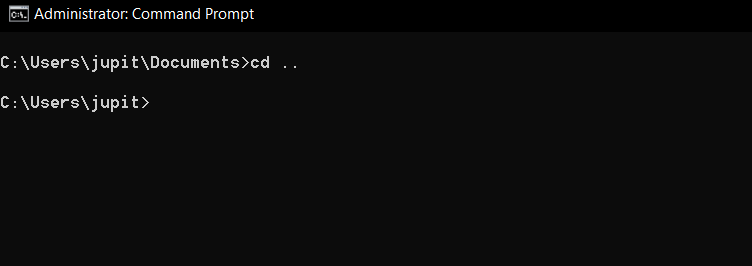
You can also navigate to a specific path, no matter where you are, by providing the full path, starting from the root directory. Remember to use the correct syntax and spelling. To navigate to the System32 directory, type this command:
cd C: WindowsSystem32
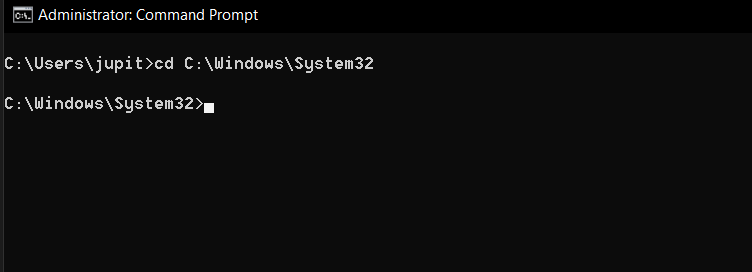
It's all about making your file system a lot more accessible. For a deeper dive into changing directories on Windows, learn how to change directories in command prompt on Windows 10.
2 dir: List Directory Contents
Do you want to see what's inside a folder without opening it? The dir (directory) command is your answer. It lists all files and directories right in the terminal. Just type dir to get a list of everything in the current directory.
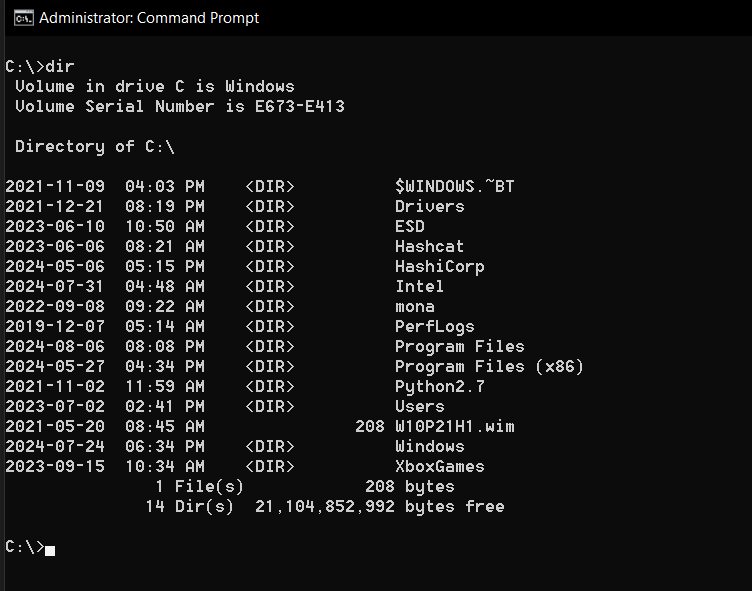
If you type dir /a you can see all files and folders, including hidden ones, displayed in the directory.
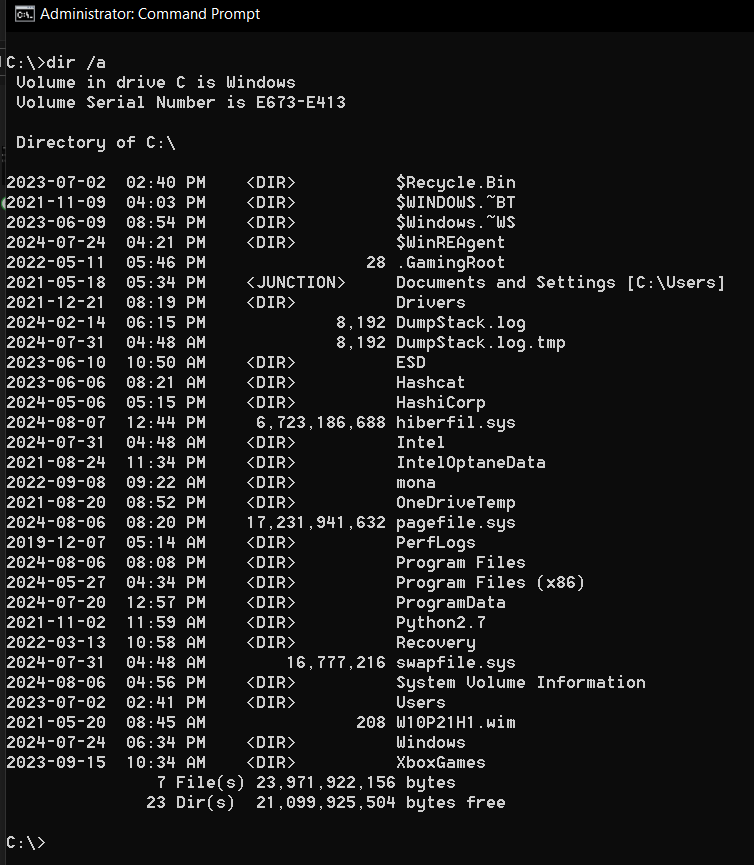
Use the Tab key to auto-complete file and directory names while typing commands, saving time and reducing errors.
3 mkdir: Create New Directories
Organize your files in a snap with the mkdir (make directory) command. Create new folders wherever you want. Creating a new folder is as simple as typing this command:
mkdir NewFolder
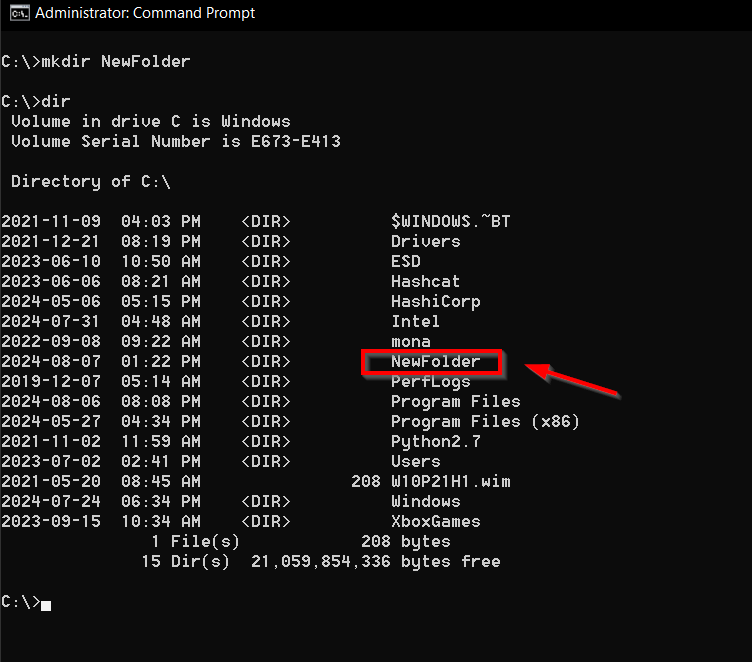
This command is a great way to keep your system organized.
If you want to create a nested directory structure in one go, you can use the mkdir abc command. This command will create directory "a," and within "a," it will create directory "b," and within "b," it will create directory "c." It's a convenient way to set up multiple levels of directories with a single command rather than having to create each directory individually.
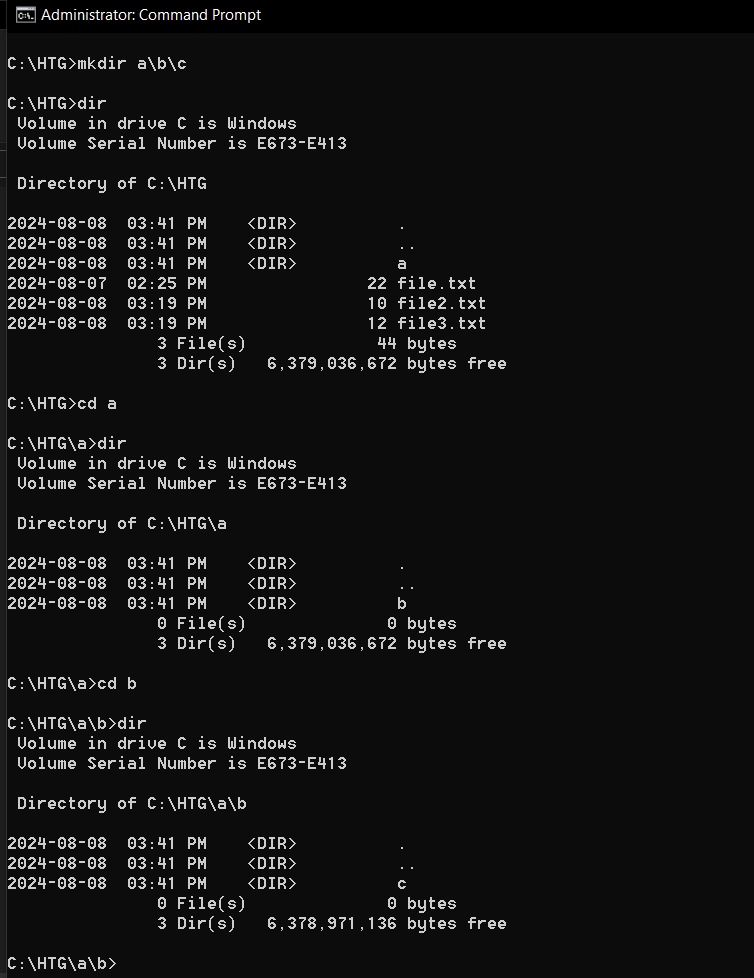
4 rmdir: Remove Directories
Do you have an empty folder you don’t need? The rmdir (remove directory) command will take care of it. But if it’s not empty, you’ll need a different approach. To remove an empty directory, simply type:
rmdir NewFolder
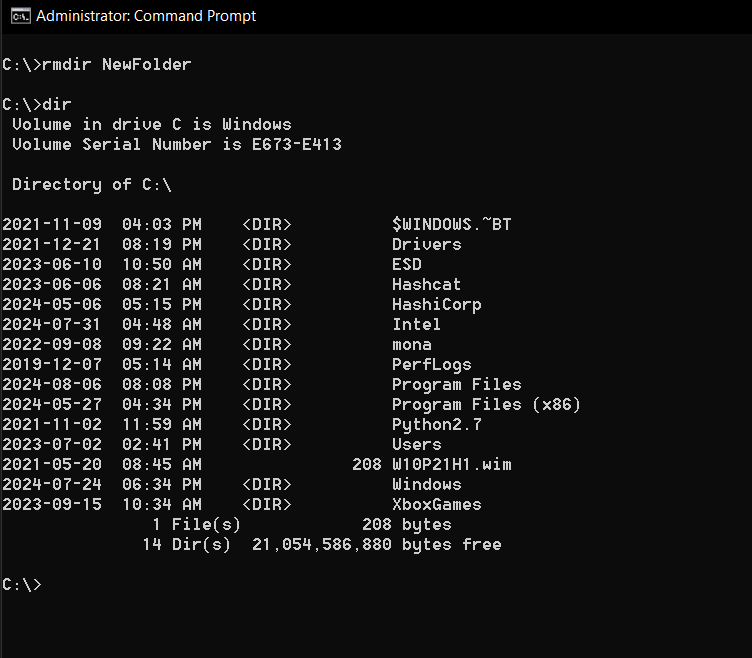
To remove a directory along with everything within it, use the rmdir /s NewFolder command.
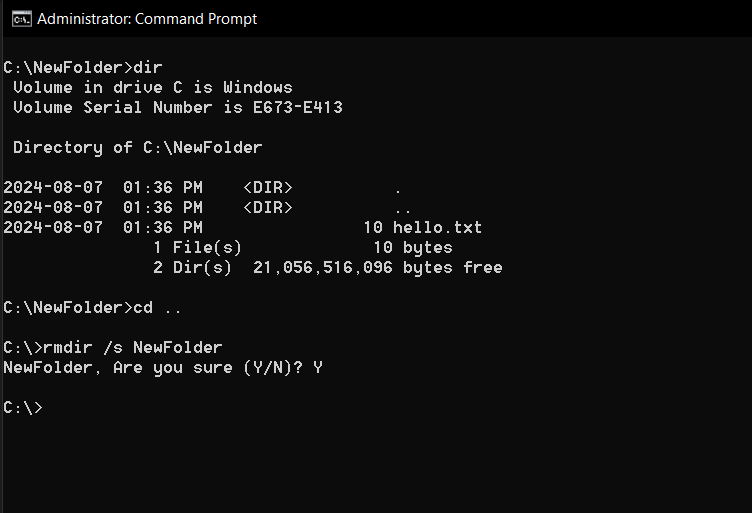
Just be careful with that second one, and make sure you really want everything gone.
When using the mkdir or rmdir commands, you won't see any confirmation message if the action is successful. To ensure the directory has been created or removed, you can use the dir command to list the contents of the current directory. If the action is successful, the new directory will appear or disappear from the list accordingly.
If you need more information on a specific command, simply enter help followed by the command. For example, if you need more information on the rmdir command, type the help rmdir command.
5 del: Delete Files
Do you need to delete a file? The del command will do it. Use it wisely because once it's gone, it's gone (sort of). Deleted files on hard drives aren't immediately erased, while on solid-state drives, the data may be wiped more quickly.
To delete a file, type the command del followed by the file(s) you want to delete. For example, to delete file.txt, type this:
del file.txt
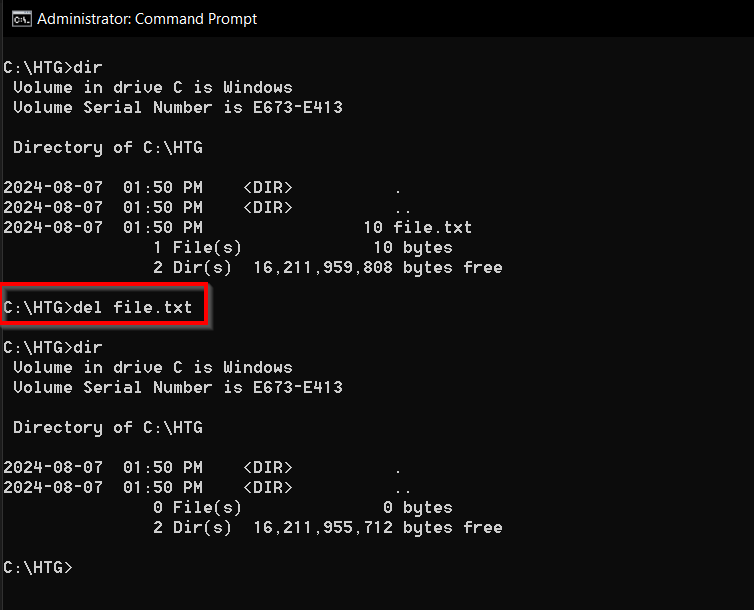
It’s a powerful command, so handle it with care.
The del command doesn't print anything in response to its use, which might surprise you. Once you run the command, the file will be deleted silently. You can verify that the file has been deleted by using the dir command to check the contents of the directory where the file was located.
6 copy: Copy Files to Another Location
Do you want to back up your files? The copy command makes duplicating files a breeze. To copy file.txt to the C:Backup folder, type the following:
copy file.txt C:Backup

By using the wildcard symbol "*" followed by the file extension, you can copy all files with the same extension. For example, to copy all text files to the C:Backup directory, you use this command:
copy * .txt C:Backup
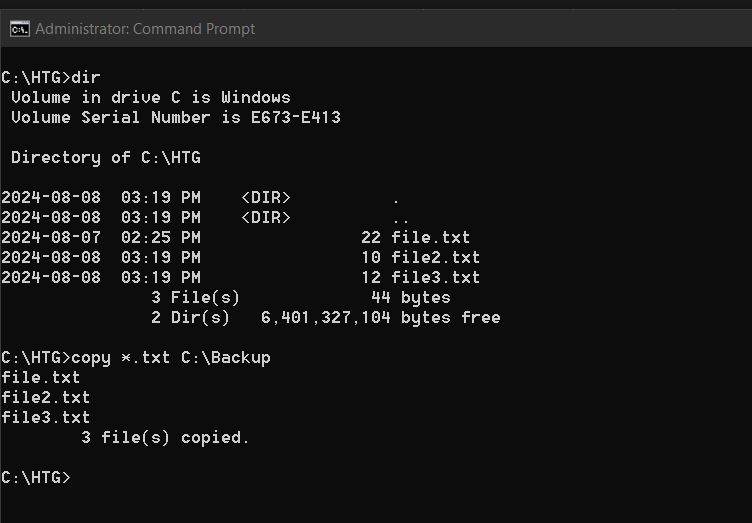
Press F7 to view and select from your command history. This allows you to easily re-run previous commands without retyping them.
7 move: Move Files to a New Location
Are you reorganizing your files? The move command lets you move files around on Windows without having to copy them to a new location. To move a file, use the move command followed by the filename and, finally, the location where you want it moved.
As an example, to move file.txt to the C:Backup folder, type this command:
move file.txt C:Backup
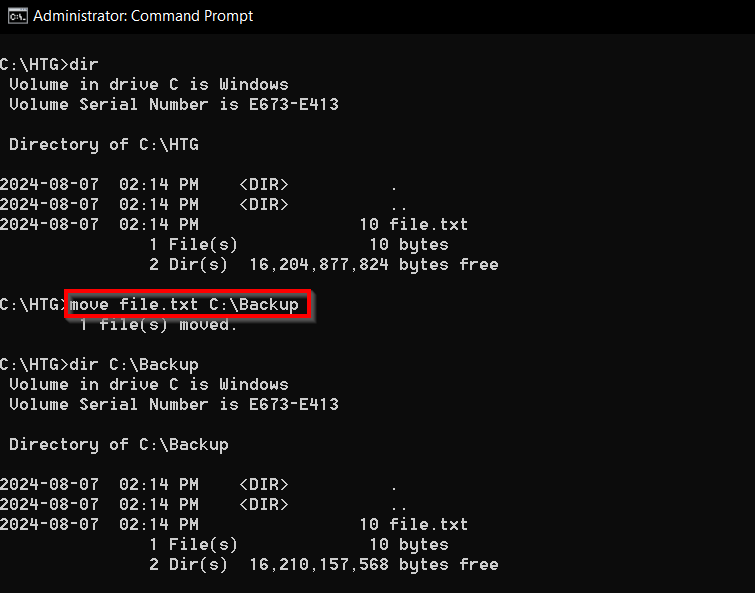
8 type: Display the Contents of a Text File
Do you want to peek inside a text file without opening it? The type command displays its contents right in the terminal. This can be done by entering type followed by the text file you want to read. To read file.txt, use this command:
type file.txt

The cls command clears all text from the terminal screen, giving you a clean slate to work from.
9 systeminfo: View System Information
The systeminfo command provides an overview of your Windows system, perfect for troubleshooting or satisfying your curiosity. It displays information such as the operating system version, processor type, and installed RAM. It also includes details about the computer's network configuration.
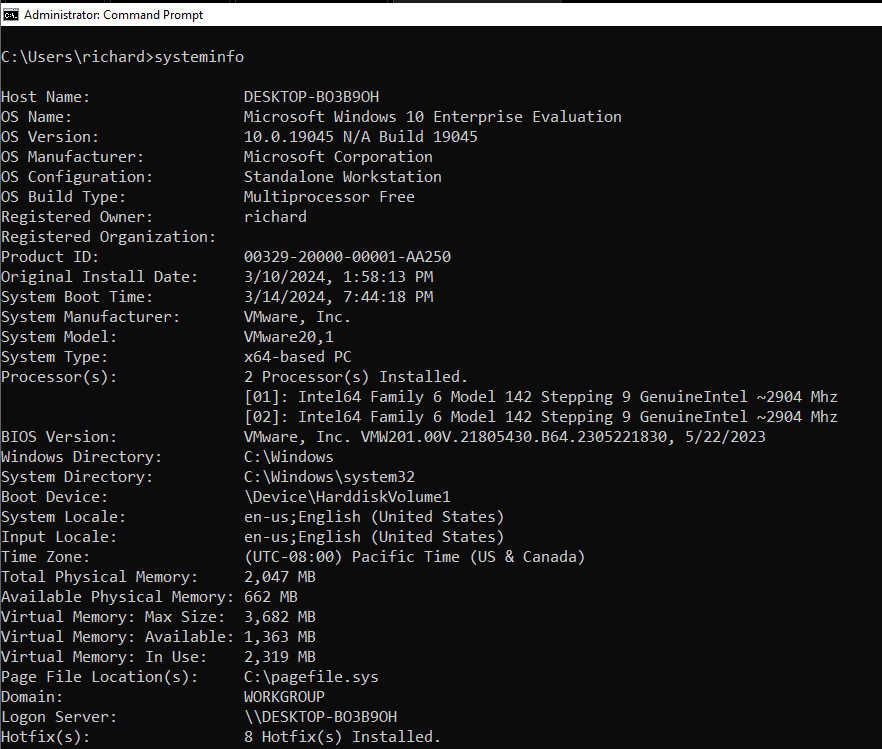
10 tree: Display Directory Structure
The tree command displays a graphical representation of the directory structure of a drive or path. It's a handy way to see the layout of your files and folders. To see the structure of the Users directory, type this command:
tree C:Users

So there you have it: 10 basic Windows commands for beginners that will make you feel like a computer whiz. Practice these commands, and you'll soon be navigating, managing, and troubleshooting your Windows system with ease. Keep exploring, keep experimenting, and watch your command-line skills grow.
Your changes have been saved
Email is sent
Email has already been sent
Please verify your email address.
Send confirmation emailYou’ve reached your account maximum for followed topics.
-
 New World: Aeternum Crashing on Launch on PC – Fix GuideNew World: Aeternum crashing on your computer? This problem is reported by several game players. But how can you resolve this issue to enjoy the game ...Software tutorial Published on 2024-11-06
New World: Aeternum Crashing on Launch on PC – Fix GuideNew World: Aeternum crashing on your computer? This problem is reported by several game players. But how can you resolve this issue to enjoy the game ...Software tutorial Published on 2024-11-06 -
 I Use These Apps to Get Windows 11 Features on My MacWhen I switched from Windows to Mac, I was frustrated by the lack of basic features I had gotten used to. But after months of testing, I found these a...Software tutorial Published on 2024-11-06
I Use These Apps to Get Windows 11 Features on My MacWhen I switched from Windows to Mac, I was frustrated by the lack of basic features I had gotten used to. But after months of testing, I found these a...Software tutorial Published on 2024-11-06 -
 6 Ways to Fix Certain Websites Not Loading on MacBasic Fixes Restart your Mac: Start the solution hunt by restarting your Mac. To do so, click the Apple logo at the top-left corner and select Restart...Software tutorial Published on 2024-11-06
6 Ways to Fix Certain Websites Not Loading on MacBasic Fixes Restart your Mac: Start the solution hunt by restarting your Mac. To do so, click the Apple logo at the top-left corner and select Restart...Software tutorial Published on 2024-11-06 -
 How to Bypass Windows 11 Minimum Installation RequirementsOfficially, you can't install Windows 11 on ineligible hardware because of Secure Boot and TPM hardware requirements. However, there are two easy ...Software tutorial Published on 2024-11-06
How to Bypass Windows 11 Minimum Installation RequirementsOfficially, you can't install Windows 11 on ineligible hardware because of Secure Boot and TPM hardware requirements. However, there are two easy ...Software tutorial Published on 2024-11-06 -
 The 6 Best Tools in Windows 11 To Help With Remote Work ProductivityWith so many of us working remotely, it's not a surprise that Windows 11 comes with a few built-in focus tools to help us get our jobs done. But ...Software tutorial Published on 2024-11-06
The 6 Best Tools in Windows 11 To Help With Remote Work ProductivityWith so many of us working remotely, it's not a surprise that Windows 11 comes with a few built-in focus tools to help us get our jobs done. But ...Software tutorial Published on 2024-11-06 -
 Game Bar Error 0x8232360F: 3 Solutions to Resolve ItGame Bar on Windows enables users to record or screenshot during the game time. However, some users cannot use this utility with the Game Bar error 0x...Software tutorial Published on 2024-11-06
Game Bar Error 0x8232360F: 3 Solutions to Resolve ItGame Bar on Windows enables users to record or screenshot during the game time. However, some users cannot use this utility with the Game Bar error 0x...Software tutorial Published on 2024-11-06 -
 How to Add and See Birthdays on iPhone CalendarBirthdays are always a special milestone in everyone’s lives. But with the ever-growing circle of friends and acquaintances, it can become hard to kee...Software tutorial Published on 2024-11-06
How to Add and See Birthdays on iPhone CalendarBirthdays are always a special milestone in everyone’s lives. But with the ever-growing circle of friends and acquaintances, it can become hard to kee...Software tutorial Published on 2024-11-06 -
 How to Use the Journal App on Your iPhoneFor a long time, if you wanted to journal on your iPhone, you needed a third-party app. But Apple finally took charge and rolled out the Journal app w...Software tutorial Published on 2024-11-06
How to Use the Journal App on Your iPhoneFor a long time, if you wanted to journal on your iPhone, you needed a third-party app. But Apple finally took charge and rolled out the Journal app w...Software tutorial Published on 2024-11-06 -
 5 Ways to Fix iPhone Reminders Not Working in iOS 17Basic Fixes: Restart the Reminders app: If the Reminders app runs into unexpected glitches or bugs, it might not work as expected on your iPhone. When...Software tutorial Published on 2024-11-06
5 Ways to Fix iPhone Reminders Not Working in iOS 17Basic Fixes: Restart the Reminders app: If the Reminders app runs into unexpected glitches or bugs, it might not work as expected on your iPhone. When...Software tutorial Published on 2024-11-06 -
 How to Recover Unsaved or Deleted Notepad FileHave you ever encountered a situation where the Notepad file was closed unexpectedly before you could save the edited content? You are organizing the ...Software tutorial Published on 2024-11-06
How to Recover Unsaved or Deleted Notepad FileHave you ever encountered a situation where the Notepad file was closed unexpectedly before you could save the edited content? You are organizing the ...Software tutorial Published on 2024-11-06 -
 8 Tricks That\'ll Give Your Old Android Phone Another Year of Life (Or More)Android phone in a bit of a lull? Before you give it a kick and toss, a small change here and some optimization over there can dramatically improve t...Software tutorial Published on 2024-11-06
8 Tricks That\'ll Give Your Old Android Phone Another Year of Life (Or More)Android phone in a bit of a lull? Before you give it a kick and toss, a small change here and some optimization over there can dramatically improve t...Software tutorial Published on 2024-11-06 -
 Can\'t Wait for the Latest Windows 11 Update (24H2)? Here\'s How to Get It NowWindows 11 24H2 brings handy features like sharing files to Android devices directly from Windows Share and performance improvements to select AMD CPU...Software tutorial Published on 2024-11-06
Can\'t Wait for the Latest Windows 11 Update (24H2)? Here\'s How to Get It NowWindows 11 24H2 brings handy features like sharing files to Android devices directly from Windows Share and performance improvements to select AMD CPU...Software tutorial Published on 2024-11-06 -
 Top 6 Fixes for Lightshot Not Working on Windows 11Lightshot is a free screen capture tool available for Windows and Mac. You can grab screenshots, share them with others, or upload them to its cloud s...Software tutorial Published on 2024-11-06
Top 6 Fixes for Lightshot Not Working on Windows 11Lightshot is a free screen capture tool available for Windows and Mac. You can grab screenshots, share them with others, or upload them to its cloud s...Software tutorial Published on 2024-11-06 -
 Phones Are As Powerful As PCs, So Why Don\'t They Need Fans?Mobile phones grow more powerful every year. A premium phone is far more powerful than a midrange PC and even has stronger graphics processing than a...Software tutorial Published on 2024-11-06
Phones Are As Powerful As PCs, So Why Don\'t They Need Fans?Mobile phones grow more powerful every year. A premium phone is far more powerful than a midrange PC and even has stronger graphics processing than a...Software tutorial Published on 2024-11-06 -
 How to Fix Outlook Conflict Message Issues – 7 Easy MethodsGo to your calendar and locate the conflicting meeting. Update or cancel the meeting as needed. Save the changes and check if the conflict message di...Software tutorial Published on 2024-11-06
How to Fix Outlook Conflict Message Issues – 7 Easy MethodsGo to your calendar and locate the conflicting meeting. Update or cancel the meeting as needed. Save the changes and check if the conflict message di...Software tutorial Published on 2024-11-06
Study Chinese
- 1 How do you say "walk" in Chinese? 走路 Chinese pronunciation, 走路 Chinese learning
- 2 How do you say "take a plane" in Chinese? 坐飞机 Chinese pronunciation, 坐飞机 Chinese learning
- 3 How do you say "take a train" in Chinese? 坐火车 Chinese pronunciation, 坐火车 Chinese learning
- 4 How do you say "take a bus" in Chinese? 坐车 Chinese pronunciation, 坐车 Chinese learning
- 5 How to say drive in Chinese? 开车 Chinese pronunciation, 开车 Chinese learning
- 6 How do you say swimming in Chinese? 游泳 Chinese pronunciation, 游泳 Chinese learning
- 7 How do you say ride a bicycle in Chinese? 骑自行车 Chinese pronunciation, 骑自行车 Chinese learning
- 8 How do you say hello in Chinese? 你好Chinese pronunciation, 你好Chinese learning
- 9 How do you say thank you in Chinese? 谢谢Chinese pronunciation, 谢谢Chinese learning
- 10 How to say goodbye in Chinese? 再见Chinese pronunciation, 再见Chinese learning

























